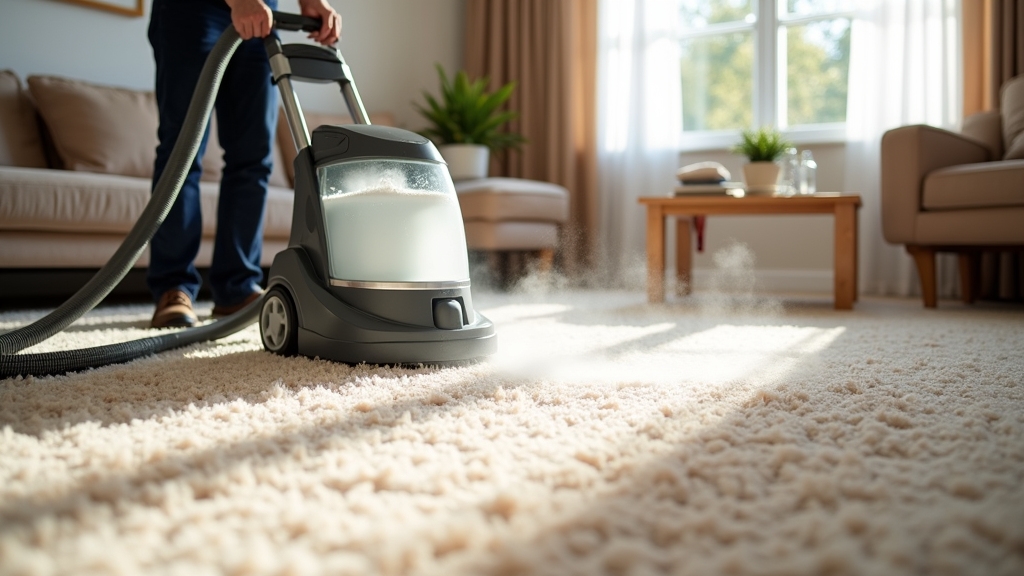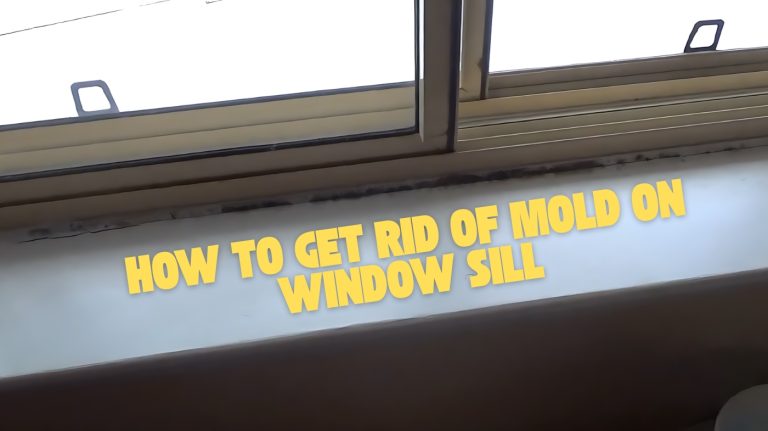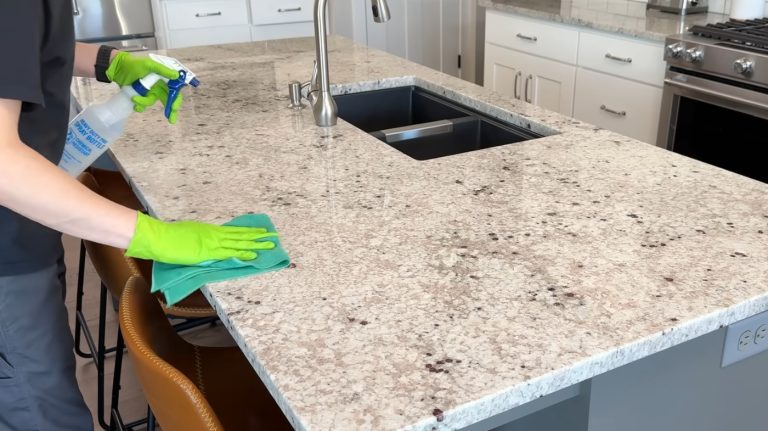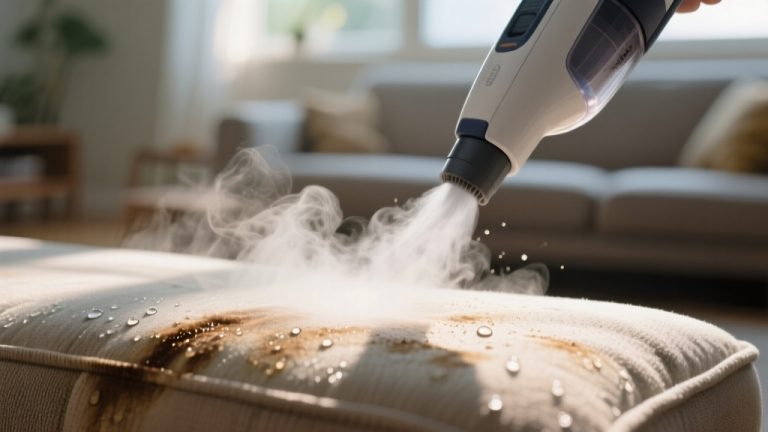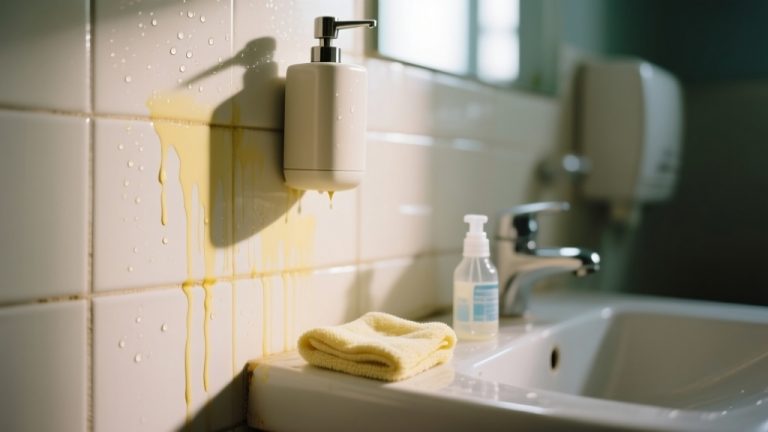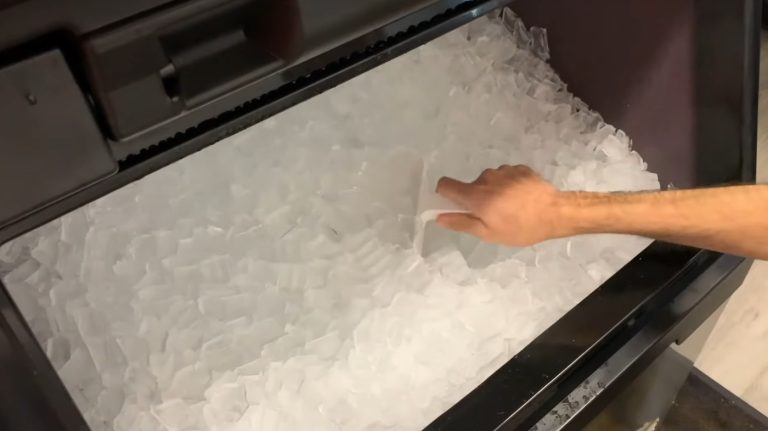How Long Does a Carpet Cleaning Take? Realistic Timing Guide
You can expect carpet cleaning to take about 20 to 60 minutes per average room, depending on its size and condition. Smaller rooms usually clean quicker, while larger or heavily soiled carpets need more time.
Drying can add several hours, especially with steam cleaning. Additional stain treatment or furniture moving also increases total time.
Different cleaning methods affect speed and drying, too. Understanding these factors helps set realistic expectations and reveals how to streamline the process.
Key Takeaways
- Carpet cleaning typically takes 20–60 minutes per average-sized room, depending on room size and soil severity.
- Dry cleaning methods usually take 15–30 minutes per room and dry within 2–4 hours.
- Steam cleaning requires 4–24 hours to dry, with deeper cleaning but longer downtime.
- Furniture removal, stain treatment, and room prep add 15–40 minutes to total cleaning time.
- Drying times vary from 6 to 12 hours, influenced by humidity, airflow, and carpet density.
Average Time Required to Clean One Room
Although cleaning times vary by room size and method, you can generally expect a professional carpet cleaning to take between 20 and 60 minutes per average-sized room (200–400 sq ft). It is important to ensure proper ventilation during cleaning to maintain air quality.
Professional carpet cleaning usually takes 20 to 60 minutes per average-sized room (200–400 sq ft).
Smaller rooms around 100–200 sq ft usually require 20 to 30 minutes, while larger rooms over 400 sq ft may take 60 to 90 minutes or more.
Steam cleaning, the most common method, typically falls within this range, though dry cleaning can be faster, often 15 to 30 minutes per room.
Professionals save time through efficient equipment and experience, completing an average room in about 20 to 40 minutes.
Keep in mind, steps like pre-vacuuming, spot treatment, and furniture moving influence the total time, but 30 minutes is a reliable baseline for an average room. Additionally, heavy stains or large furniture can extend the cleaning time beyond typical durations.
Factors Affecting Carpet Cleaning Duration
When it comes to carpet cleaning, size definitely matters! The bigger the carpet, the more time it’s going to take to get it all cleaned up. It’s also important to consider the cleaning environment, as factors like humidity levels can affect drying time.
But it’s not just the size that affects cleaning time. The method you choose plays a big role, too. Some techniques need more time for application or drying, so keep that in mind when making your choice.
And let’s not forget about those pesky stains and dirt buildup. If you’ve got some tough spots, you can expect the process to take a bit longer since they need extra attention and treatment. Additionally, furniture moving can add to the total cleaning time since the area must be cleared and rearranged before and after cleaning.
Carpet Size Impact
How does carpet size influence your cleaning timeline? Simply put, the larger the carpet, the more time you’ll need.
Cleaning an average room carpet usually takes about 20 minutes, but once you exceed 300 sq ft, expect 30 to 45 minutes or more. The total time scales directly with carpet area, especially if multiple rooms are involved. Just as with natural stone surfaces, understanding the material properties is key to managing cleaning efficiently.
Efficient crews match their size to the carpet’s scale, speeding up furniture moving and cleaning. Additionally, moving furniture can add to the total time required for cleaning, especially in larger spaces where more items may need to be relocated, so it is important to factor in furniture moving time.
| Carpet Size | Cleaning Time |
|---|---|
| Small (<150 sq ft) | ~10-15 minutes |
| Medium (150-300) | ~20-30 minutes |
| Large (>300) | 30-45+ minutes |
| Whole House | Several hours total |
Keep in mind, bigger carpets mean more prep, moving, and careful coordination.
Cleaning Method Differences
Because different carpet cleaning methods vary widely in technique and moisture use, the time required for each can differ markedly.
For instance, carbonation cleaning uses carbonated bubbles and minimal moisture, drying within 1-2 hours. This makes it ideal for quick turnarounds. Additionally, carbonation cleaning is eco-friendly due to its low water and chemical usage.
Steam cleaning sprays hot water under pressure, delivering deep cleaning but demands 4-24 hours of drying. Proper airflow and air circulation strategies can help reduce this drying time significantly.
Encapsulation cleaning employs synthetic foam that crystallizes dirt and dries rapidly, suitable for light to moderate soils.
Shampoo methods agitate and vacuum detergent but may leave residues and require extended drying similar to steam cleaning.
Bonnet and absorbent compound cleaning rely on low moisture and surface absorption, resulting in quicker drying but less deep cleaning.
Your choice directly affects carpet downtime, efficiency, and suitability for soil levels.
Stain and Soil Severity
Different carpet cleaning methods set the stage, but the severity of stains and soil often dictates how long the process takes.
You’ll find that organic, oily, or mixed soils need longer, specialized treatments. Older, set-in stains require stronger chemicals and repeated passes. Proper preparation and safety measures, such as ensuring ventilation and protective gear, can also impact the overall cleaning duration.
Large or hard-to-reach stains add extra time, while deep soil penetration demands extended agitation. Delicate fibers force gentler, slower approaches. Additionally, heavily soiled carpets generally require more intensive, time-consuming treatments.
| Factor | Impact on Cleaning Time |
|---|---|
| Soil Type | Organic/oil soils need longer treatment |
| Stain Age | Older stains require multiple treatments |
| Size & Location | Large, scattered, or hidden stains slow process |
| Fiber Type | Delicate fibers require gentler care |
| Soil Penetration | Deeper soils increase dwell/agitation time |
Comparison of Different Cleaning Methods
When you’re picking a cleaning method for your carpets, it’s good to know that steam cleaning usually takes the longest. We’re talking several hours here, thanks to its deep extraction process.
Hot water extraction, also known as steam cleaning, uses high-pressure hot water combined with natural cleaning agents to effectively extract dirt deep within carpet fibers through powerful suction, but it requires up to 8 hours including drying time. It’s important to allow carpets to air dry naturally and avoid heat sources to prevent damage, similar to how leather cleaning requires gentle care.
On the other hand, if you’re in a hurry, you might want to consider dry cleaning options like bonnet or dry powder methods. They can get the job done in just minutes! However, keep in mind that with speed comes a bit of a trade-off in terms of thoroughness. These quick methods typically only clean the surface layer of the carpet, treating about an inch deep.
Oh, and don’t forget that the efficiency of your equipment is super important too! It can really impact how quickly and effectively your carpets get cleaned. So, whether you value speed or deep cleaning, make sure you choose the right tools for the job!
Steam Cleaning Duration
Although steam cleaning offers a deep and thorough carpet cleanse, it typically requires considerably more time than other methods.
You should expect 20–60 minutes per standard room, with larger or heavily soiled rooms taking over an hour. Proper ventilation is important during cleaning to avoid the buildup of harmful fumes.
Drying can take 6–12 hours or more, depending on carpet type and environmental conditions. With traditional steam cleaning involving large water use, the drying process usually extends to the higher end of this range due to longer drying times.
| Factor | Time Range | Notes |
|---|---|---|
| Standard Room | 20–60 minutes | Size, carpet type affect timing |
| Large/Special Rooms | 60+ minutes | Heavy stains or pet odors |
| Drying Time | 6–12 hours | Longer for thick or wool carpets |
| Drying Aids | 2–3 hours | Fans or dehumidifiers accelerate |
Plan accordingly to accommodate these variables for ideal results.
Dry Cleaning Speed
Since drying time is often a major concern, you’ll appreciate that dry cleaning methods considerably cut down the wait compared to wet cleaning.
Dry cleaning typically dries within 2 to 4 hours because it focuses on surface-level cleaning rather than deep extraction. Companies like Chem-Dry and Oxi-Fresh use these systems to deliver faster results with acceptable cleanliness. However, the effectiveness of any method greatly depends on having a skilled technician who manages moisture and cleaning properly. Choosing the right cleaning method can also help preserve the quality and longevity of your carpet fibers.
In contrast, wet cleaning methods, such as steam cleaning, require 6 to 24 hours or more to dry due to their deeper cleaning action.
While dry cleaning won’t remove deeply embedded dirt as effectively, it’s ideal when time is tight and surface dirt is your primary concern.
Keep in mind, environmental factors like airflow and humidity still influence drying speed, but dry cleaning offers a reliable way to minimize downtime.
Equipment Efficiency Impact
Understanding how equipment efficiency impacts carpet cleaning can help you choose the right method for your needs.
Machines with dual tank systems prevent dirt re-deposit by separating clean and dirty water, ensuring thorough cleaning. High suction power, like that in Shark CarpetXpert, extracts deep dirt but may slow you down due to weight. The balance between cleaning power and maneuverability is similar to how granite’s hardness affects its scratch resistance and usability.
Models with larger water tanks reduce refill frequency, speeding up the process. Commercial-grade models often feature large tank capacities, making them ideal for extensive or frequent cleaning tasks.
Simultaneous cleaning and drying systems, such as Hoover SmartWash, cut overall time by combining stain treatment and drying passes.
Steam cleaners sanitize quickly but focus less on dirt extraction than carpet extractors, which clean deeper but take longer.
Lightweight, portable machines increase maneuverability but may sacrifice cleaning power and capacity.
Balance your priorities between speed, efficiency, and cleaning depth when selecting equipment.
Impact of Carpet Size and Condition on Cleaning Time
When you’re planning carpet cleaning, the size and condition of your carpet play essential roles in determining how long the process will take.
Small rooms (100-200 sq ft) usually need 20-30 minutes, while medium rooms (200-400 sq ft) take 30-60 minutes. Larger rooms can require 60-90 minutes or more. Cleaning times can also vary depending on whether there are stubborn stains present.
If you’re cleaning multiple rooms, expect several hours.
The carpet’s condition also affects timing: heavily soiled carpets demand more intensive treatments and pre-spray applications, extending the process.
Damaged carpets or those requiring furniture removal add extra time.
Choosing professional services can speed things up, thanks to efficient equipment and expertise.
Ultimately, the larger and dirtier your carpet, the longer the cleaning will take, so consider these factors when scheduling your service.
Additional Time for Stain and Odor Treatments
Although routine carpet cleaning can be straightforward, treating stains and odors often demands considerably more time.
Stain treatment typically adds 15 to 30 minutes per affected area, especially for stubborn stains requiring multiple applications and dwell times of 5–15 minutes.
Stain treatment adds 15–30 minutes per area, especially for stubborn stains needing multiple applications and dwell times.
Manual scrubbing can extend this by at least 10 minutes per stain.
Odor treatments usually add another 15 to 30 minutes, with enzymatic products needing wait periods before extraction. It is often advisable to seek professional stain removal when stains persist despite immediate spot cleaning efforts.
Severe odors, like pet or smoke, may require repeated applications and longer dwell times, prolonging the process further.
Additionally, specialized machines or ozone treatments can tack on 20–40 minutes.
These interventions often double the cleaning duration for a room, plus necessitate extra drying time and post-treatment inspections to guarantee effective stain and odor removal.
Time Needed for Furniture Removal and Room Preparation
Since furniture removal and room preparation directly impact the efficiency of carpet cleaning, you’ll want to plan accordingly. Moving small items yourself before the cleaners arrive can save 15 to 30 minutes. Heavy furniture usually stays put unless you arrange extra service.
Besides moving furniture, clearing clutter, vacuuming, securing pets, and ensuring power access are key prep steps. It is also important to clear floor of furniture, rugs, and objects to allow better access to the carpet and facilitate thorough cleaning.
| Task | Average Time Needed |
|---|---|
| Moving small furniture | 5–15 minutes per room |
| Clearing clutter | 5–10 minutes |
| Vacuuming carpet | 10–15 minutes |
| Arranging access & pets | 5 minutes |
Efficient prep minimizes delays, allowing cleaners to cover the entire carpet quickly without staged cleaning. This consequently keeps your session within the estimated timeframe.
Drying Times and How They Influence Total Duration
Proper preparation, including moving furniture and clearing clutter, sets the stage for efficient carpet cleaning, but the overall duration doesn’t end once the cleaning equipment is put away.
Drying times vary widely: hot water extraction carpets typically feel dry in 6 to 8 hours but can take up to 12 hours. Full drying for safe furniture placement may require up to 24 hours. Using high-velocity fans can significantly speed up the drying process.
Dry cleaning methods shorten this to 2 to 4 hours. Factors like humidity, temperature, airflow, and carpet type play key roles. High humidity and dense fibers slow drying, while good ventilation and warmth speed it up.
You should avoid walking on damp carpets to prevent damage. Remember, delayed drying risks mold, odors, and subfloor damage.
Allow sufficient time before replacing furniture or heavy use.
Efficiency Tips for Faster Carpet Cleaning
When you optimize your equipment and streamline your workflow, you can considerably cut down carpet cleaning time without sacrificing quality.
Maintain your machines regularly and choose advanced vacuums with rotating bristles for faster dirt removal. Establishing regular maintenance schedules helps prevent unexpected breakdowns that can delay cleaning jobs.
Prioritize pre-treating stains and vacuuming thoroughly before cleaning to avoid repeated efforts.
Use encapsulation cleaning for quicker drying and efficient dirt extraction.
| Tip Category | Action | Benefit |
|---|---|---|
| Equipment | Use rotating bristle vacuums | Faster embedded dirt removal |
| Workflow | Pre-treat in crisscross pattern | Maximizes stain removal |
| Stain Treatment | Blot spills immediately | Prevents stain spread |
| Product Selection | Use low-water encapsulation agents | Speeds drying and cleaning cycle |
Typical Time Estimates for Whole-House Cleaning
Knowing efficiency tips can help speed up your cleaning process, but understanding typical time estimates for whole-house carpet cleaning sets realistic expectations.
Efficiency tips speed cleaning, but knowing typical time frames helps set realistic expectations for whole-house carpet care.
For a standard 3–4 bedroom home with 1000 to 2000 sq ft of carpet, expect 3 to 4 hours of cleaning. Each room usually takes 15 to 60 minutes, depending on size and carpet condition.
Larger homes or heavily soiled carpets require more time. Moving furniture adds to the total duration.
Most professionals use steam cleaning, which demands longer drying, typically 6 to 12 hours post-cleaning. Steam cleaning is effective for deep stain removal and is suitable for most carpet types.
Dry cleaning methods are faster but less common for whole-house jobs.
Keep in mind, severity of stains, carpet type, and the number of technicians influence the overall timeframe.
Preparing well and choosing the right method helps guarantee a smooth, timely cleaning.
Frequently Asked Questions
Can Carpet Cleaning Damage My Carpet Fibers or Colors?
Yes, carpet cleaning can damage your fibers or colors if done improperly.
Using harsh chemicals, aggressive scrubbing, or over-wetting can fade colors, weaken fibers, and cause mold.
However, when you choose the right cleaning methods and professionals who understand your carpet type, you’ll protect its integrity.
Regular, gentle cleaning and proper drying help maintain appearance without harm.
Always avoid abrasive techniques and unsuitable products to keep your carpet looking great.
How Often Should Carpets Be Professionally Cleaned?
You should get your carpets professionally cleaned every 12 to 18 months if your home has low traffic and no pets or kids.
For busier households with pets or children, aim for every 3 to 6 months.
If allergies or asthma affect you, consider cleaning every 2 to 3 months.
Adjust based on your carpet type, household size, and lifestyle to keep your carpets fresh and extend their lifespan effectively.
Are There Eco-Friendly Carpet Cleaning Options Available?
Yes, you’ll find plenty of eco-friendly carpet cleaning options.
Methods like encapsulation, dry compound, and dry steam cleaning use minimal water and biodegradable products.
You can also choose green-certified detergents or natural enzyme-based cleaners like Eco-Me or Puracy.
These options reduce environmental impact, improve indoor air quality, and are safe around kids and pets.
Plus, DIY alternatives with baking soda or vinegar work great for spot treatments and deodorizing.
What Should I Do to Prepare My Home Before Cleaning?
You should vacuum carpets thoroughly, including edges and upholstery, and clear all carpeted areas by moving small furniture and removing fragile items.
Guarantee a 5-foot clearance around upholstery for better access.
Secure pets and keep utilities on.
Provide parking near the entrance for equipment.
Remove bedding from mattresses if needed.
Finally, clear hallways and staircases for unobstructed access, and inform cleaners about any stains or problem spots for targeted treatment.
Can Carpet Cleaning Remove All Types of Pet Odors?
Carpet cleaning can remove most pet odors, especially if treated quickly and professionally.
However, it won’t eliminate all odors entirely, particularly those soaked deep into padding or subfloor.
You’ll find synthetic fibers easier to refresh than porous ones.
For stubborn smells, you might need multiple treatments or even padding replacement.
Using specialized odor neutralizers and enzyme-based cleaners improves results, but complete removal depends on odor age, carpet type, and treatment thoroughness.
Plan Ahead with Confidence: Know Your Carpet Cleaning Timeline
When it comes to carpet cleaning, remember that “slow and steady wins the race.” While one room might take anywhere from 30 minutes to an hour, factors like carpet size, condition, and extra treatments can extend the time.
Preparing the room and drying also add to the total duration. By understanding these elements, you can plan efficiently and even expedite the process without sacrificing quality. A well-paced approach ensures the best results every time.

